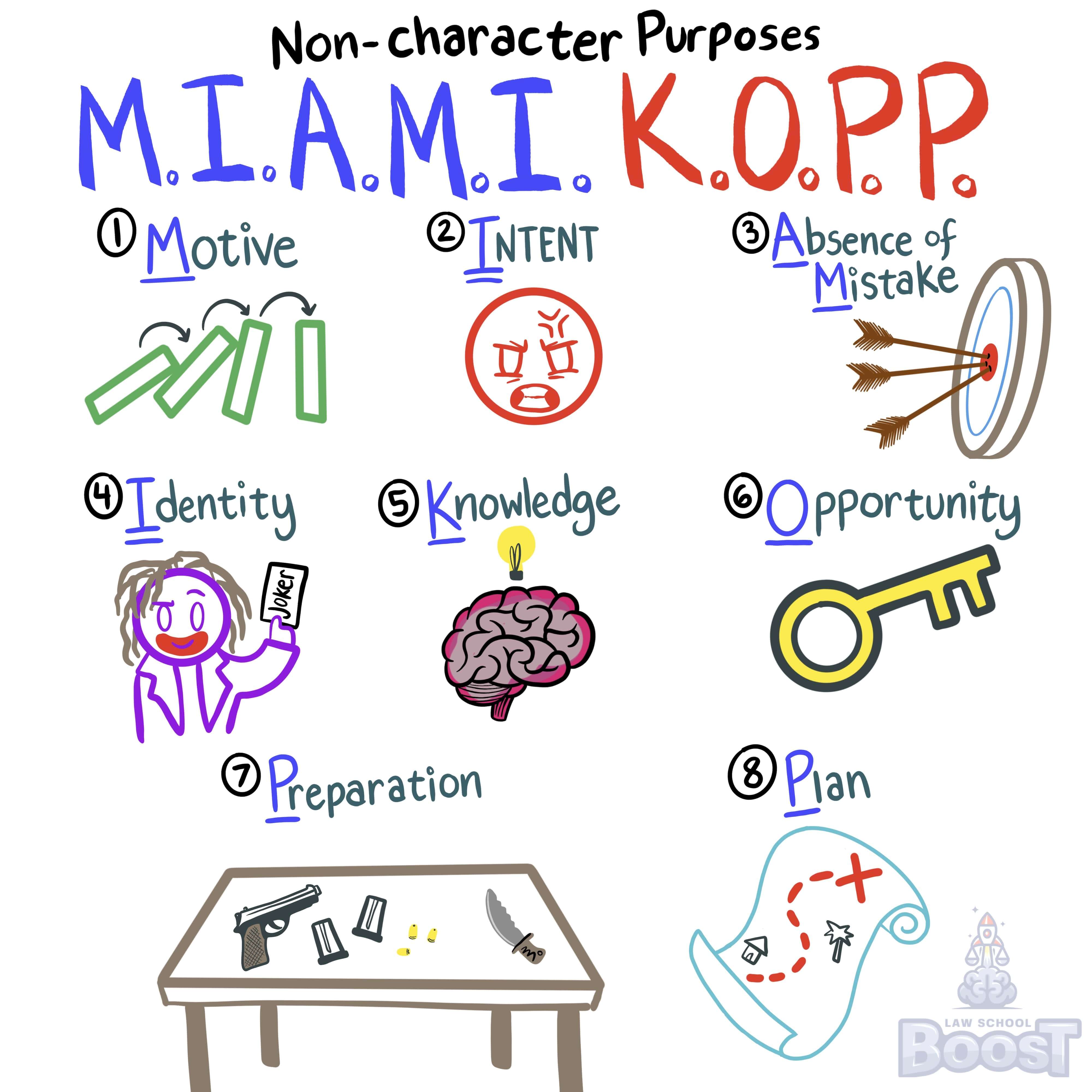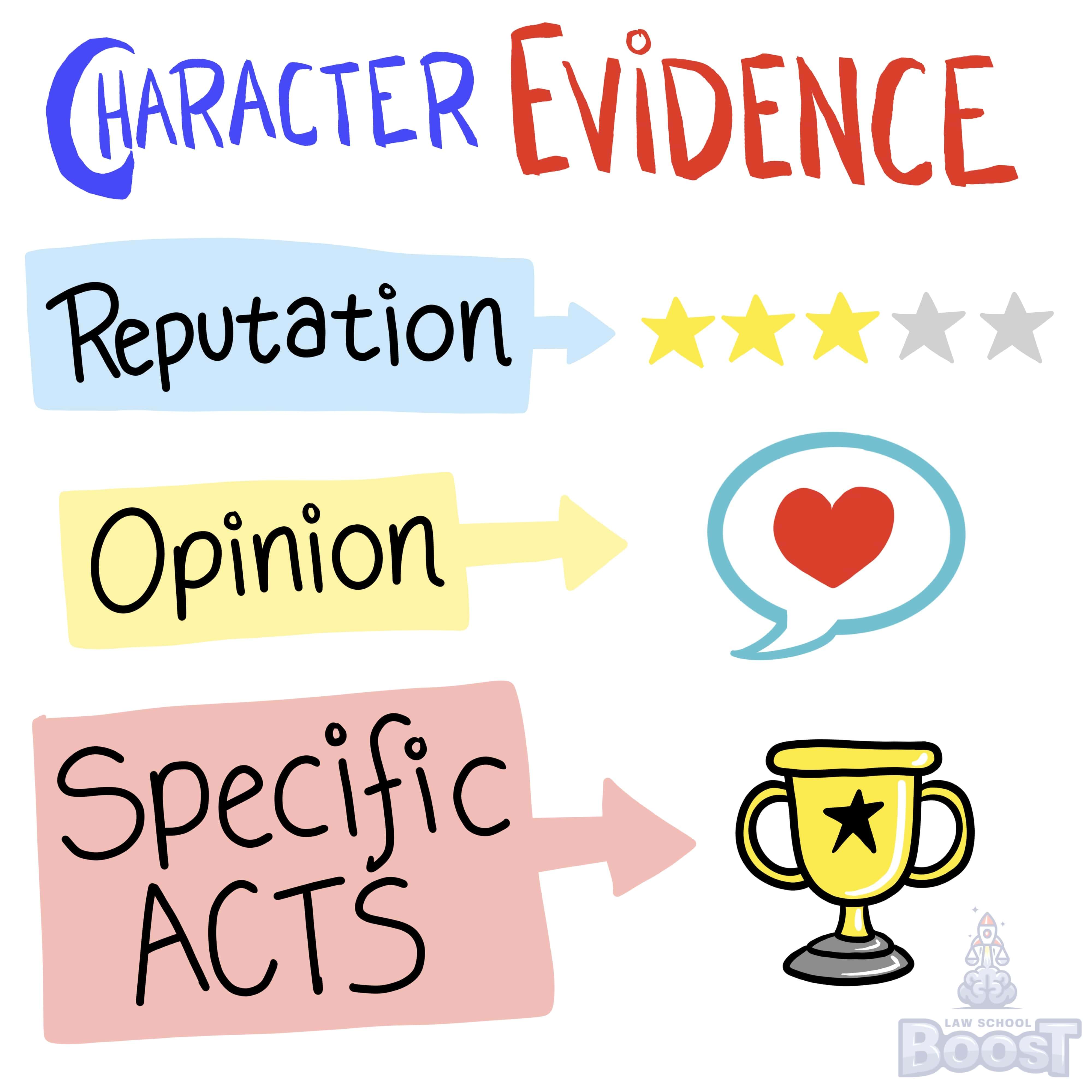🦅
Federal Evidence • Character Evidence
EVID#067
Legal Definition
Evidence that is otherwise reflective of character may be used for certain non-character related purposes: M.I.A.M.I. K.O.P.P.
(1) Motive
(2) Intent
(3) Absence of Mistake (or accident)
(4) Identity
(5) Knowledge
(6) Opportunity
(7) Preparation
(8) Plan
(1) Motive
(2) Intent
(3) Absence of Mistake (or accident)
(4) Identity
(5) Knowledge
(6) Opportunity
(7) Preparation
(8) Plan
Plain English Explanation
While character evidence has various limitations in how it may be used in court to establish someone's character, there are various reasons you can use character evidence for "non-character" related purposes. On an exam, you would first recognize the potential for certain evidence to be considered character evidence, and then it's up to you to try to fit it into one of these non-character uses if possible. There are 8 such purposes commonly tested:
(1) Motive: Evidence of a defendant’s prior conviction and parole might seem like character evidence suggesting they are generally criminal. However, it could be used to establish a motive in a case where they're accused of killing an officer for a parole violation, showing why the defendant might have been motivated to commit this specific act.
(2) Intent: Evidence of a defendant’s previous violent acts toward a specific victim might seem like character evidence suggesting they are inherently violent. However, this could be used, for example, to show intent in a case where they're accused of harming or killing that victim, especially if they claim the act was accidental.
(3) Absence of Mistake: Evidence of a defendant attending a seminar on sophisticated methods of financial fraud and having access to books about hiding fraudulent transactions might seem like character evidence suggesting they have an interest in commiting financial crimes, but in a trial over embezzling funds from their employer where the defendant is claiming they made an unintentional accounting error, this evidence would demonstrate that their actions were not accidental but actually part of a pattern of knowledgeable behavior regarding fraudulent activities.
(4) Identity: Evidence of a defendant’s unique method in committing crimes might seem like character evidence suggesting they are a habitual criminal. However, it could be used to identify them as the perpetrator in a case involving a similar method, showing the distinctiveness of their criminal actions.
(5) Knowledge: Evidence of a defendant’s past involvement in the drug trade might seem like character evidence suggesting they are criminally inclined. However, in a drug trafficking case, it could be used to argue they were likely aware of the illegal nature of the packages they transported.
(6) Opportunity: Evidence that a defendant had keys to a stolen car might seem like character evidence suggesting they have a tendency to steal. However, this could be used to show they had the opportunity to commit the alleged theft, focusing on the circumstances of the specific incident.
(7) Preparation: Evidence that a defendant purchased items like rope and duct tape might seem like character evidence suggesting they are prone to violence. However, in a kidnapping case, it could be used to show preparation and planning, indicating forethought and intent for the specific crime.
(8) Plan: Evidence of a defendant's theft of an ice cream truck might seem like character evidence suggesting they are a common thief. However, in an armed robbery case, it could be used to show that the theft was part of a larger plan to rob a bank and that they realized they would need a large truck for the heist, illustrating a calculated strategy rather than random criminal behavior.
(1) Motive: Evidence of a defendant’s prior conviction and parole might seem like character evidence suggesting they are generally criminal. However, it could be used to establish a motive in a case where they're accused of killing an officer for a parole violation, showing why the defendant might have been motivated to commit this specific act.
(2) Intent: Evidence of a defendant’s previous violent acts toward a specific victim might seem like character evidence suggesting they are inherently violent. However, this could be used, for example, to show intent in a case where they're accused of harming or killing that victim, especially if they claim the act was accidental.
(3) Absence of Mistake: Evidence of a defendant attending a seminar on sophisticated methods of financial fraud and having access to books about hiding fraudulent transactions might seem like character evidence suggesting they have an interest in commiting financial crimes, but in a trial over embezzling funds from their employer where the defendant is claiming they made an unintentional accounting error, this evidence would demonstrate that their actions were not accidental but actually part of a pattern of knowledgeable behavior regarding fraudulent activities.
(4) Identity: Evidence of a defendant’s unique method in committing crimes might seem like character evidence suggesting they are a habitual criminal. However, it could be used to identify them as the perpetrator in a case involving a similar method, showing the distinctiveness of their criminal actions.
(5) Knowledge: Evidence of a defendant’s past involvement in the drug trade might seem like character evidence suggesting they are criminally inclined. However, in a drug trafficking case, it could be used to argue they were likely aware of the illegal nature of the packages they transported.
(6) Opportunity: Evidence that a defendant had keys to a stolen car might seem like character evidence suggesting they have a tendency to steal. However, this could be used to show they had the opportunity to commit the alleged theft, focusing on the circumstances of the specific incident.
(7) Preparation: Evidence that a defendant purchased items like rope and duct tape might seem like character evidence suggesting they are prone to violence. However, in a kidnapping case, it could be used to show preparation and planning, indicating forethought and intent for the specific crime.
(8) Plan: Evidence of a defendant's theft of an ice cream truck might seem like character evidence suggesting they are a common thief. However, in an armed robbery case, it could be used to show that the theft was part of a larger plan to rob a bank and that they realized they would need a large truck for the heist, illustrating a calculated strategy rather than random criminal behavior.
Hypothetical
Hypo 1 (Motive): Bob, a defendant in a theft case, is known to have recently lost his job and is struggling financially. This information might be perceived as suggesting Bob's desperation or likelihood to steal. However, in the trial, it's used specifically to establish a financial motive for why Bob might have committed the theft.
Hypo 2 (Intent): In a case where Bob is charged with car vandalism, there's evidence that he previously threatened to damage this specific car. While this might seem to suggest Bob's general aggressiveness, it's actually presented to demonstrate his intent to damage that car.
Hypo 3 (Absence of Mistake): Bob is accused of shoplifting. To counter his claim that it was accidental, the prosecution introduces evidence of his past shoplifting incidents. This might look like painting Bob as generally dishonest, but it's to show a pattern of behavior, indicating the current incident was likely intentional, not a mistake.
Hypo 4 (Identity): Bob is suspected in a series of burglaries performed with a unique method. While evidence of his knowledge and use of this method could be seen as suggesting a criminal character, it's used to link him to the crimes, establishing his identity as the burglar.
Hypo 5 (Knowledge): In a drug trafficking trial, evidence is presented showing Bob's extensive knowledge of the drug trade. This might be seen as character evidence of illegal involvement, but it's used to argue that Bob was not just accidentally involved but knowingly participated in drug trafficking.
Hypo 6 (Opportunity): Bob is accused of stealing a car. The prosecution shows that Bob had access to the car keys, which could imply he's prone to stealing. However, the key evidence is to demonstrate that Bob had the opportunity to commit the alleged theft.
Hypo 7 (Preparation): Charged with burglary, Bob is found to have a collection of burglary tools. This might suggest he's a burglar by nature, but the focus in court is on how these tools indicate Bob's preparation for the specific burglary he's charged with.
Hypo 8 (Plan): Bob faces fraud charges, and the prosecution unveils detailed plans of a fraudulent scheme found in his possession. Though this could suggest Bob's general deceitfulness, it's actually crucial in showing that Bob meticulously planned the specific fraudulent activity he's accused of.
Hypo 2 (Intent): In a case where Bob is charged with car vandalism, there's evidence that he previously threatened to damage this specific car. While this might seem to suggest Bob's general aggressiveness, it's actually presented to demonstrate his intent to damage that car.
Hypo 3 (Absence of Mistake): Bob is accused of shoplifting. To counter his claim that it was accidental, the prosecution introduces evidence of his past shoplifting incidents. This might look like painting Bob as generally dishonest, but it's to show a pattern of behavior, indicating the current incident was likely intentional, not a mistake.
Hypo 4 (Identity): Bob is suspected in a series of burglaries performed with a unique method. While evidence of his knowledge and use of this method could be seen as suggesting a criminal character, it's used to link him to the crimes, establishing his identity as the burglar.
Hypo 5 (Knowledge): In a drug trafficking trial, evidence is presented showing Bob's extensive knowledge of the drug trade. This might be seen as character evidence of illegal involvement, but it's used to argue that Bob was not just accidentally involved but knowingly participated in drug trafficking.
Hypo 6 (Opportunity): Bob is accused of stealing a car. The prosecution shows that Bob had access to the car keys, which could imply he's prone to stealing. However, the key evidence is to demonstrate that Bob had the opportunity to commit the alleged theft.
Hypo 7 (Preparation): Charged with burglary, Bob is found to have a collection of burglary tools. This might suggest he's a burglar by nature, but the focus in court is on how these tools indicate Bob's preparation for the specific burglary he's charged with.
Hypo 8 (Plan): Bob faces fraud charges, and the prosecution unveils detailed plans of a fraudulent scheme found in his possession. Though this could suggest Bob's general deceitfulness, it's actually crucial in showing that Bob meticulously planned the specific fraudulent activity he's accused of.
Visual Aids


Related Concepts
How do California's rules differ from the Federal rules when it comes to introducing character evidence in a case involving sexual assault or child molestation?
How is the process of offering character evidence generally handled in California?
How is the process of offering character evidence generally handled under the Federal rules?
If the defendant offers evidence of a victim's bad character, what can the prosecution offer to rebut?
In California, if the defendant offers evidence of a victim's violent character, what can the prosecution offer to rebut?
In California, when can prior acts of domestic violence or elder abuse be admissible?
In cases involving sexual assault, when may a defendant introduce specific act evidence?
What are habit and custom evidence?
What is character evidence?
When is character evidence admissible in civil cases?
When is character evidence admissible in criminal cases?
When is character evidence admissible in homicide cases involving self defense? What kinds are admissible?
When is evidence of prior sexual assault or child molestation admissible?


